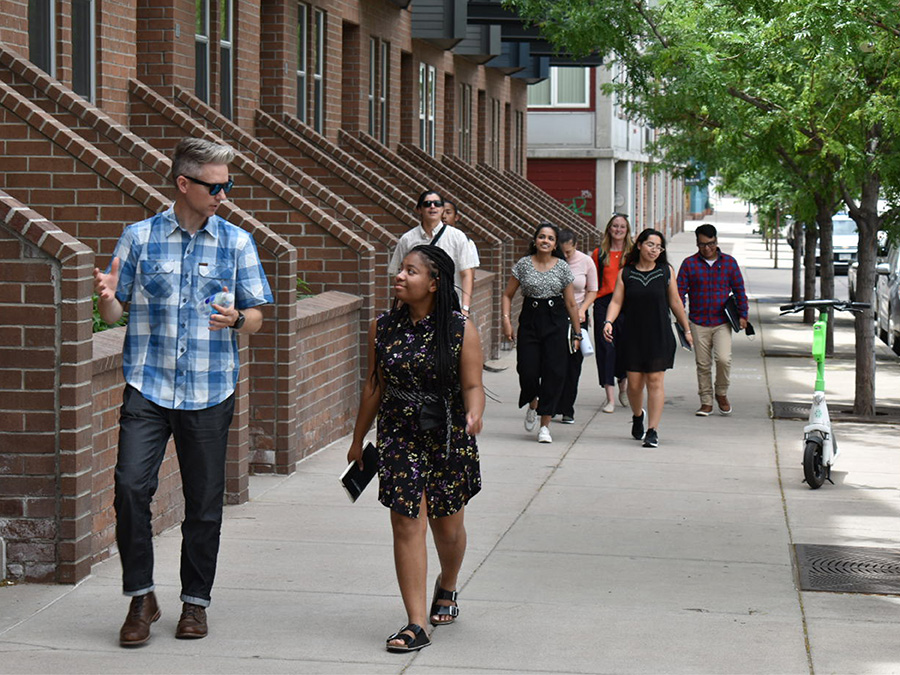News Release

Featured here, Robb tours our Denver Greening Five Points project with our Dr. Charles Fountain Interns.
Interview with Robb Berg
Posted 12/19/2022
As the year comes to a close, we reflect on the most impactful moments – from professional development to community building. In our recent interview with DW President Robb Berg, he shares what mentorship means to him, how to keep culture alive and his thoughts about the next generation of leaders.
What's your first memory of being creative?
Creativity when I was young was about problem-solving. I grew up in a family of engineers, raised in a functional, problem-solving environment where things were fixed rather than bought new. There also was always a project. A problem we were trying to solve. We were fixing stuff all the time, working on cars, building furniture, etc. And so, problem-solving was ingrained at an early age.
This adds a ton of value to how I think about solving design problems today – even subconsciously - I wouldn't change it for the world. I've always said, I'm a designer first, who just happened to find landscape architecture and absolutely love the world that I'm in.
Would you say the original meaning of creativity is the form and function together?
A good friend and mentor, Henry Beer, used to say that “we are our most creative when we have constraints and that constraints are the birth of creativity.” I don't think I truly understood that until only recently. It’s the persistence and tenacity to work through these constraints that allow truly creative people to find success.
Did you have a mentor over the years and if so, how have they influenced your career choices?
I feel lucky to have had a career so far that has been full of truly great mentors. I have had some of the very best mentors in my life and would not be where I am today if they didn’t share their very valuable time with me. Mentorship is one of my passions because it is valuable at every stage of your career. The act of sharing knowledge, time or experience is such a rewarding experience. My best days are the ones spent collaborating and interacting with those around me whether that’s meeting with interns for a few hours or working closely with my project teams. One of my favorite times of the year is Design Week, our week-long intensive involving university students where we get the opportunity to share how we do what we do and work together on a real project for a real client. Nothing brings me more joy than doing that. I hope that others have that same experience.
How do you know when a project is successful?
Success comes in so many different forms. There is the internal satisfaction we feel of working through a design problem. When you come out on the other side and find a solution that checks all the boxes, it is a great feeling. External validation is also an important component of success. Our collaborative design reviews give us the ability to “throw things on the wall,” get immediate feedback, iterate, and see real progress. You see the reaction from others as you work your way through to a solution and when we receive that positive reaction you have created something of value.
Has the meaning of success changed for you from earlier in your career?
For sure. I had a very narrow field of what success was supposed to be when I first got into this field twenty years ago. I was focused on creating things, projects, and design for design’s sake. Today, I have a much broader view of success. Success for me is building strong and diverse teams. It’s having a strong culture as a firm. It is about building community with the world around us, as well as fostering community at Design Workshop.
You’re just coming off an intensive design week with students from Mississippi State. Were there any light bulb moments over the course of the week about the up-and-coming generation of new hires?
Today’s students have the capacity to take information in, distill it, and generate outcomes that are meaningful in a very short amount of time. An example is our Charles Fountain Internship Program. In our time together the student-led team takes a real design problem, conducts research, iterates multiple design solutions until identifying the most appropriate solution, quantify its impact and outcomes, and present it in 6-7 short weeks to actual clients. It’s phenomenal. When I was a student, I didn’t have that capacity. I'm so encouraged and excited for where we're headed as a profession because I think every generation of new designers takes on a new set of new complexities that maybe the previous generation didn't have to deal with. It underscores why landscape architects are so well suited for solving these complex problems. We approach things with such great perspective and context as opposed to just diving right into a specific design problem.
How do you integrate critical thinking as a part of Design Workshop’s culture?
Our Legacy Design process, now over two decades old, was developed to do just this. Those that came before were focused on creating a critical practice. Today we invest both our time and resources to provide our clients with well researched and performative solutions to their projects. Most recently we have enjoyed bringing Legacy Days to each studio. This opportunity to “hit pause” and calibrate our thinking, to align the teams towards our Legacy Design process, and performance-based design ethos has been so fun and rewarding as a firm. It’s encouraging to see staff immediately embrace the design process and incorporate it directly into their work. To be successful in this industry, we must be nimble in our thinking. Design Workshop was built on fostering exploration and entrepreneurialism. We are working harder than ever to not lose that culture.